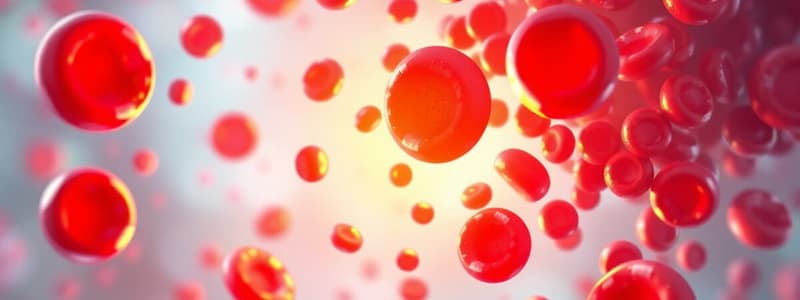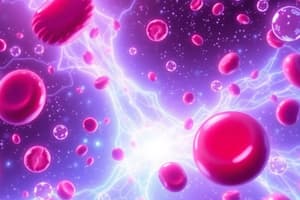Podcast
Questions and Answers
What is a characteristic of heparin that is not related to its anti-coagulant property?
What is a characteristic of heparin that is not related to its anti-coagulant property?
- It can be synthetically made in various grades and purities. (correct)
- It inhibits thrombin in the coagulation cascade.
- It is commonly used to treat thrombotic events.
- It is synthesized in the body.
Which of the following events is NOT affected by heparin's action on the coagulation cascade?
Which of the following events is NOT affected by heparin's action on the coagulation cascade?
- Inhibition of factor Xa
- Activation of antithrombin III
- Conversion of fibrinogen to fibrin
- Activation of platelets (correct)
What is the physiological consequence of heparin-induced thrombocytopenia (HIT)?
What is the physiological consequence of heparin-induced thrombocytopenia (HIT)?
- Decreased coagulation activity resulting in increased bleeding
- Enhancement of anti-coagulant effects leading to increased bleeding
- Increased risk of bleeding due to decreased platelet count
- Thrombosis due to pro-coagulant effects of heparin (correct)
What is the main reason for monitoring platelet count in patients receiving heparin?
What is the main reason for monitoring platelet count in patients receiving heparin?
In the context of HIT, what is the most accurate description of heparin's effect?
In the context of HIT, what is the most accurate description of heparin's effect?
What is the critical threshold for platelet count reduction that should raise suspicion of HIT?
What is the critical threshold for platelet count reduction that should raise suspicion of HIT?
What is the recommended course of action if HIT is suspected in a patient on heparin?
What is the recommended course of action if HIT is suspected in a patient on heparin?
What is the most likely outcome of HIT if left untreated?
What is the most likely outcome of HIT if left untreated?
What is one of the main complications associated with thrombocytopenia in patients with HIT?
What is one of the main complications associated with thrombocytopenia in patients with HIT?
Which factor binds with heparin to expose an immune epitope leading to HIT?
Which factor binds with heparin to expose an immune epitope leading to HIT?
Which assay is used to confirm the presence of IgG antibodies against the PF4/heparin complex in patients suspected of having HIT?
Which assay is used to confirm the presence of IgG antibodies against the PF4/heparin complex in patients suspected of having HIT?
What is the primary immune response triggered by the formation of the heparin-PF4 complex?
What is the primary immune response triggered by the formation of the heparin-PF4 complex?
What is the outcome of the binding of antibodies to the heparin-PF4 complex?
What is the outcome of the binding of antibodies to the heparin-PF4 complex?
In delayed-onset HIT, when do patients typically present with unexplained thrombocytopenia following heparin therapy?
In delayed-onset HIT, when do patients typically present with unexplained thrombocytopenia following heparin therapy?
Which condition is NOT typically a manifestation of a hypercoagulable state due to HIT?
Which condition is NOT typically a manifestation of a hypercoagulable state due to HIT?
What is a common clinical feature observed in patients diagnosed with HIT?
What is a common clinical feature observed in patients diagnosed with HIT?
A patient presents with a history of heparin exposure and a low platelet count. Which of the following statements is TRUE about HIT Type I, based on the provided context?
A patient presents with a history of heparin exposure and a low platelet count. Which of the following statements is TRUE about HIT Type I, based on the provided context?
Which of the following factors makes HIT Type II a life-threatening condition?
Which of the following factors makes HIT Type II a life-threatening condition?
A patient who has received heparin in the past develops a low platelet count within 24 hours of restarting heparin therapy. This scenario is MOST consistent with which type of HIT?
A patient who has received heparin in the past develops a low platelet count within 24 hours of restarting heparin therapy. This scenario is MOST consistent with which type of HIT?
Why is HIT more common with unfractionated heparin (UFH) compared to low molecular weight heparin (LMWH)?
Why is HIT more common with unfractionated heparin (UFH) compared to low molecular weight heparin (LMWH)?
Which of the following is NOT a diagnostic test for HIT?
Which of the following is NOT a diagnostic test for HIT?
Which of the following is a crucial step in the management of a patient with HIT?
Which of the following is a crucial step in the management of a patient with HIT?
What is the range for normal platelet count in a healthy individual, as stated in the provided information?
What is the range for normal platelet count in a healthy individual, as stated in the provided information?
Which of the following statements is TRUE regarding the relationship between heparin purity and HIT development?
Which of the following statements is TRUE regarding the relationship between heparin purity and HIT development?
Flashcards
Heparin
Heparin
An anticoagulant that activates antithrombin III to inhibit thrombin and factor Xa, preventing clotting.
Antithrombin III
Antithrombin III
A protein that inactivates thrombin and factor Xa, critical in the anticoagulation process.
Fibrinogen
Fibrinogen
A soluble plasma protein that is converted to fibrin by thrombin, leading to clot formation.
Heparin-Induced Thrombocytopenia (HIT)
Heparin-Induced Thrombocytopenia (HIT)
Signup and view all the flashcards
Pro-coagulant Effect
Pro-coagulant Effect
Signup and view all the flashcards
Thrombotic Events
Thrombotic Events
Signup and view all the flashcards
Platelet Count Monitoring
Platelet Count Monitoring
Signup and view all the flashcards
Side Effects of Heparin
Side Effects of Heparin
Signup and view all the flashcards
HIT Type I
HIT Type I
Signup and view all the flashcards
HIT Type II
HIT Type II
Signup and view all the flashcards
Serotonin release assay
Serotonin release assay
Signup and view all the flashcards
Trombocytopenia
Trombocytopenia
Signup and view all the flashcards
Clinical Scoring
Clinical Scoring
Signup and view all the flashcards
Alternative anticoagulant
Alternative anticoagulant
Signup and view all the flashcards
Platelet transfusion
Platelet transfusion
Signup and view all the flashcards
Delayed-onset HIT
Delayed-onset HIT
Signup and view all the flashcards
Heparin-PF4 complex
Heparin-PF4 complex
Signup and view all the flashcards
IgG antibodies in HIT
IgG antibodies in HIT
Signup and view all the flashcards
Clinical manifestations of HIT
Clinical manifestations of HIT
Signup and view all the flashcards
4T Score
4T Score
Signup and view all the flashcards
Anti-PF4 test
Anti-PF4 test
Signup and view all the flashcards
Study Notes
Heparin-Induced Thrombocytopenia (HIT)
- HIT is a life-threatening complication of heparin exposure
- It occurs regardless of the dose, schedule, or route of administration
- Heparin is given as unfractionated heparin (UFH) or low molecular weight (LMWH) heparin
- HIT is more common with UFH than LMWH due to greater immunogenicity and cross-reactivity with PF4
Types of HIT
-
Type I HIT (non-immune):
- Mild, temporary drop in platelet count within the first two days of heparin exposure
- Platelet count returns to normal with heparin discontinuation
- Direct effect of heparin on platelets by non-immune-mediated platelet aggregation
- Not clinically significant
-
Type II HIT (immune-mediated):
- Immune-mediated disorder that occurs 5-14 days after heparin exposure
- Has life-and limb-threatening thrombotic complications
- Rapid, typical, and delayed onset are subtypes
- Typical HIT: Onset 5-14 days after heparin therapy
- Rapid HIT: Can occur in patients with prior heparin exposure within the last 100 days, and platelet count falls within 24 hours of starting heparin
- Delayed HIT: Patients develop HIT and thrombosis/thrombocytopenia up to 3 weeks after heparin discontinuation
HIT Pathophysiology
- Heparin binds to platelet factor 4 (PF4)
- This exposes a masked immune epitope
- Formation of heparin-PF4 complex triggers production of immunoglobulin (Ig) G antibodies
- Premature thrombocyte clearance leads to thrombocytopenia
- Antibodies bind to heparin-PF4 complex
- Form circulating immune complexes (CICs)
- CICs bind to FC receptors on platelets
- Platelet activation, platelet aggregation, thrombosis, and hypercoagulability
- Platelet activation leads to additional PF4 release
- Stimulates the immunoreaction further
HIT Clinical Manifestations
- Hypercoagulable state
- Thrombocytopenia
- Complication:
- Deep vein thrombosis (most common)
- Pulmonary embolism (most common)
- Myocardial infarction
- Limbs artery occlusion (possibly amputation)
- Transient ischemic attack (TIA) and stroke
- Skin necrosis
- End-organ damage (adrenal, bowel, spleen, gallbladder, or hepatic infarction; renal failure)
- Death
HIT Diagnosis (4T score)
-
Thrombocytopenia: Platelet count falls > 50% and count is ≥ 20 x 10⁹/L
-
Timing of platelet fall: Clear onset between days 5-14, or platelet fall within 1 day (prior heparin exposure within 30 days)
-
Thrombosis or other sequelae: New thrombosis or skin necrosis at heparin injection sites; or anaphylactoid reaction after IV heparin bolus
-
Other causes of thrombocytopenia: None apparent
-
Scoring:
- 0, 1, or 2 points are assigned to each category
- Scores of 4 or more indicate high probability for HIT
HIT Diagnostic Assays
-
Anti-PF4 test: Immunological assay detecting IgG antibodies against the PF4/heparin complex
- Sensitive but not specific (can detect but not specifically define the antigen)
-
Serotonin Release Assay: Functional assay measuring heparin-dependent platelet activation
- Confirmatory test
- Better predictor of thrombosis than anti-PF4 assay
Studying That Suits You
Use AI to generate personalized quizzes and flashcards to suit your learning preferences.





